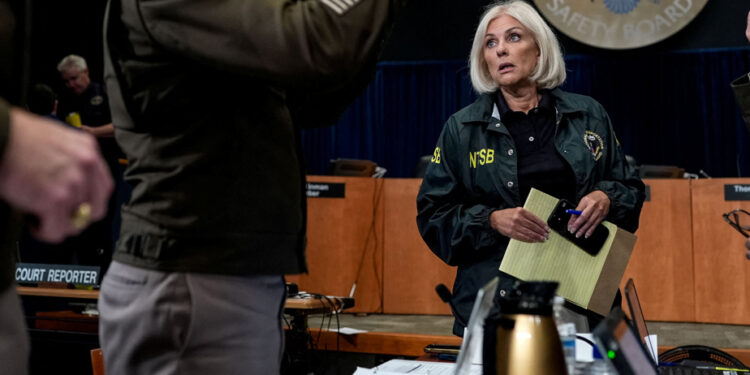(New York) The investigation into the deadly collision at the end of January in Washington between an airliner and an American army helicopter highlighted several tens of meters in the altitude displayed by the instruments of the military apparatus, according to hearings carried out in Washington.
The American Transport Safety Agency (NTSB) held investigative hearings on Wednesday to Friday, with advanced interrogations of experts and representatives of the various parties (companies, regulator, air controllers, etc.) concerned by this accident.
The collision, which killed 67 people in total, occurred on January 29 near Ronald-Reagan airport in the American capital between a military helicopter Sikorsky Black Hawk-who was carrying out a training flight-and a CRJ700 bomber operated by a subsidiary of the American Airlines.
As of February 14, relying on the data of the flight recorders, the NTSB had reported an “divergence” concerning the altitude of the helicopter.
Jennifer Homendy, agency director, said that, shortly before the collision, the helicopter pilot had reported an altitude of 300 feet while her pilot-instructor indicated 400 feet.
“None of the pilots made a comment on the divergence of altitude,” she noted. “At this point, we do not know why there was a divergence between the two. »»
“At the time of the collision, the Black Hawk was at 278 feet. But I want to warn that this does not mean that (…) This is what the Black Hawk crew saw on the barometric altimeters in the cockpit, “she said, evoking” conflicting information in the data “.
Same model, same battalion
As part of the investigation, the hearings this week revealed, tests were carried out with three copies of the same Sikorsky Black Hawk Lima model, belonging to the same battalion.
They highlighted differences between the altitude indicated by the altimeter by radar and the barometric altimeter, installed on this device.
In an “controlled environment, the gap was within the tolerated limit of 20 to 55 feet (but), once the Rotors were running and produced an elevation and a push, the indications of the altimeter (barometric) fell significantly and remained it throughout the flight time”, explained Marie Moler, one of the investigators, specifying that a “difference of 80 to 130 feet” meters, had been noted.
It is a “very important” gap in this case, insisted Jennifer Homendy with journalists. “A 100 feet difference is important,” she added.
Indeed, in the section where the collision occurred, helicopters had to fly at 200 feet above sea level.
“I am worried. There is a possibility that what the crew saw was very different from what altitude was actually, “she continued. “This is something we are going to continue to examine,” she said.
In addition, criticisms had come forward after the accident, when it appeared that the same controller managed the traffic of helicopters and part of the traffic in the aircraft in the tower.
According to Clark Allen, an employee of the FAA air regulator who worked until recently in this control tower, this accumulation – authorized by regulations – was “probably more frequent” than a dissociation of roles.
He also answered in the affirmative of the question of whether the hierarchical supervision of the staff of the tower was sufficient that evening, also agreed that the workforce was quite numerous if it had been necessary to dissociate the management of helicopters.



